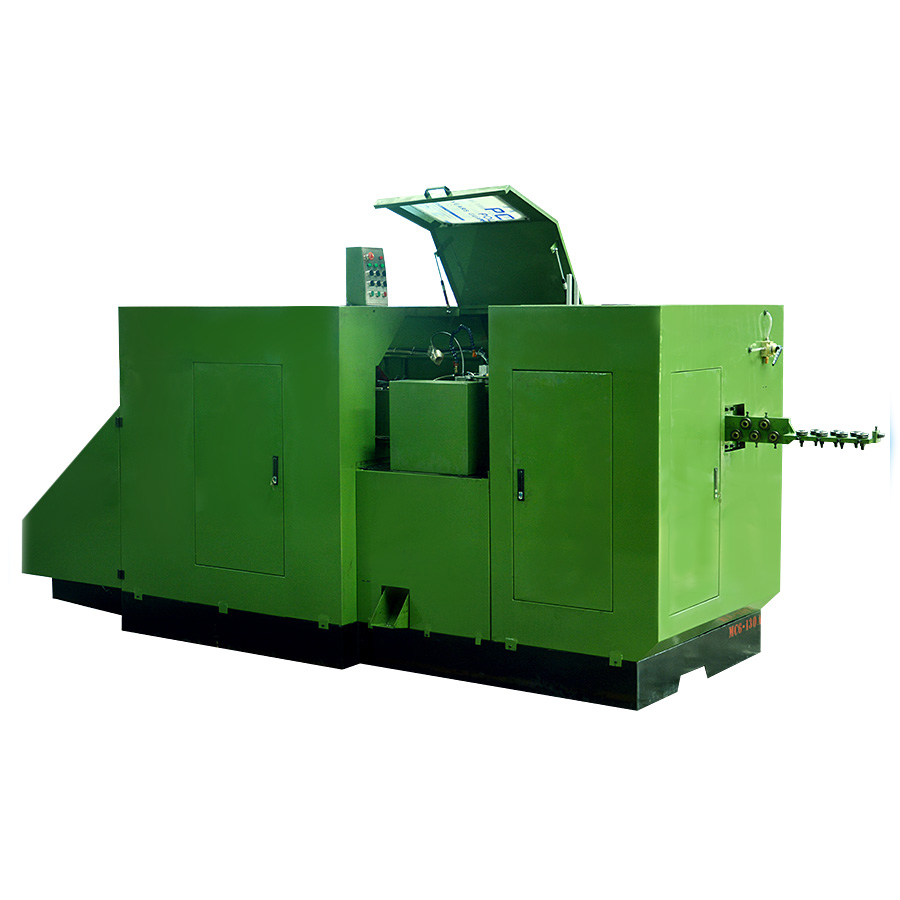1. What is a Multi-Station 3-Die 3-Blow Cold Heading Machine?
A multi-station 3-die 3-blow cold heading machine is a specialized piece of equipment used in the manufacturing of fasteners and other components through a cold forming process. Unlike simpler machines, this machine performs three distinct forming operations (blows) using three sets of dies in a single cycle, allowing for more complex shapes and higher precision.
2. How Does a Multi-Station 3-Die 3-Blow Cold Heading Machine Work?
The process typically involves the following steps:
Wire Feeding: A wire is fed into the machine and cut to the required length.
First Blow: The cut wire is positioned in the first die, and a punch strikes the wire to form the initial shape, such as the head of a bolt.
Second Blow: The partially formed part is moved to the second die, and another punch strikes it to refine the shape or add additional features.
Third Blow: The part is then moved to the third die, where a final punch completes the shaping process, adding threads or other features if required.
Ejection: The completed part is ejected from the dies and collected for further processing.
3. What Materials Can Be Used in a Multi-Station 3-Die 3-Blow Cold Heading Machine?
Common materials include:
Steel: Low carbon, medium carbon, and alloy steels.
Stainless Steel: For corrosion-resistant applications.
Brass: For non-magnetic and non-sparking applications.
Bronze: For high wear-resistance.
4. What Are the Advantages of Using a Multi-Station 3-Die 3-Blow Cold Heading Machine?
Advantages include:
High Production Rate: Capable of producing large quantities of parts rapidly.
Consistency: Ensures uniformity in the parts produced.
Cost-Effectiveness: Economical for mass production once set up.
Precision: Produces parts with high dimensional accuracy and tight tolerances.
Complex Shapes: Able to form more intricate shapes compared to simpler machines.
Reduced Scrap: Minimizes material waste compared to machining processes.
5. What Are the Limitations of a Multi-Station 3-Die 3-Blow Cold Heading Machine?
Limitations include:
Initial Setup Costs: Higher initial investment due to more complex tooling and setup.
Maintenance Requirements: Requires regular maintenance to keep the dies and punches in good condition.
Operator Training: Operators need specialized training to manage the machine effectively.
Design Constraints: Limited to shapes that can be formed in three blows.
6. How Is the Wire Fed Into the Machine?
The wire is typically fed from a coil or spool through a guide system that aligns it for cutting. The machine has a mechanism that measures the exact length of wire needed and cuts it before the forming process begins. Some machines use automatic wire feed systems to ensure consistent length and alignment.
7. Can the Multi-Station 3-Die 3-Blow Cold Heading Machine Handle Threading?
Yes, the machine can handle threading operations, often integrating thread rolling as part of the third blow. This ensures that the threading process is seamless and efficient, resulting in high-quality threads.
8. What Is the Difference Between Cold Heading and Hot Heading?
Cold Heading: Performed at room temperature, using the material's natural properties to form the part without heating.
Hot Heading: Involves heating the material to make it more malleable before forming, which can allow for more complex shapes but may require additional cooling steps.
9. How Do You Maintain a Multi-Station 3-Die 3-Blow Cold Heading Machine?
Regular maintenance includes:
Cleaning: Keeping the machine and its components clean.
Lubrication: Applying lubricants to moving parts to reduce wear.
Inspection: Regularly checking the dies and punches for wear or damage.
Adjustment: Ensuring all parts are properly aligned and adjusted.
Servicing: Performing scheduled servicing as recommended by the manufacturer.
10. How Do You Troubleshoot Common Issues in Multi-Station 3-Die 3-Blow Cold Heading Machines?
Common issues include:
Misalignment: Check and adjust the position of the dies and punches.
Worn Tooling: Replace worn or damaged dies and punches.
Irregular Shapes: Adjust the tooling or modify the forming parameters.
Jamming: Clear any blockages and inspect for bent or broken components.
11. What Safety Precautions Should Be Taken When Operating a Multi-Station 3-Die 3-Blow Cold Heading Machine?
Safety precautions include:
Guards: Ensuring all safety guards are in place.
Training: Providing thorough training to operators.
PPE: Using personal protective equipment (PPE) such as gloves, safety glasses, and hearing protection.
Emergency Stops: Installing and maintaining emergency stop buttons.
12. Can a Multi-Station 3-Die 3-Blow Cold Heading Machine Handle Custom Designs?
Yes, with the appropriate tooling and programming, a multi-station 3-die 3-blow cold heading machine can handle custom designs. However, this may require specialized tooling and potentially longer setup times.
























































